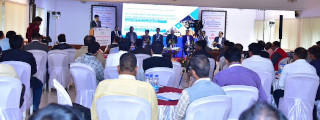Brief Overview of Fertilizer Sector
Three decades of planning and development of the fertilizer industry has brought India to the frontline of a fertilizer-producing country. The Indian fertilizer industry has made good progress in the case of Nitrogen-based fertilizers. India is the 2nd largest consumer of Urea fertilizers after China. India also ranks 2nd in the production of nitrogenous fertilizers and 3rd in phosphatic fertilizers. As far as Potassic (K) fertilizers is concerned, there is no indigenous capacity. The requirements are met entirely through imports. India meets its 80 % requirement of Urea (N), while it is heavily dependent on Imports for its potassium (K) and phosphorus (P) fertilizer requirements. The fertilizer industry of India is developed both under the Public and Private sectors.
The actual production of all the Fertilizers during the year 2018-19 was 41.485 million tonne. The estimated Production of all the Fertilizers during the year 2019-20 is expected to be 46.215 million tonne showing an increase of more than 11.40% in comparison of the previous year. As of now, the country has achieved 80% self-sufficiency in production capacity of Urea. As a result, India could manage its substantial requirement of nitrogenous fertilizers through the indigenous industry besides imports. Similarly, 50% indigenous capacity has been developed in respect of phosphatic fertilizers to meet domestic requirements.
Manufacturing Process & Energy Consumption
The urea manufacturing process comprises two major sub-processes such as production of ammonia through reformation/partial oxidation of primary fuel and urea through reaction of ammonia and carbon di-oxide. Specific energy consumption is least for gas based plant followed by fuel oil and coal based plants respectively. Electrical energy is used all the production processes whereas thermal energy is required for decomposition, drying and concentration.
As in case of cement, fertiliser sector in India too has achieved global benchmark in energy efficiency. In fact, the average specific energy consumption of the gas based plants in India is better than the global average. Apart from the feedstock, process technology and capacity utilisation are the two other major factors, which impact the SEC in urea manufacture. India has been in the forefront in adopting new technology as would be seen from the rapid stride made in reducing the SEC over the last 25 years. Typical fuel mix of Fertiliser manufacturing process is presented below:
| Types of Fuels | % |
|---|---|
| Coal | 8 |
| Grid Electricity | 2.0 |
| Gas | 90 |
In addition to technology up gradation, maintaining high productivity has also contributed in improving the energy performance of the sector.
PAT Scheme for Fertilizer Sector
The Fertiliser sector is one of the designated sectors covered under the BEE’s Perform, Achieve and Trade scheme. At present, there are 32 large size urea plants in the country manufacturing urea, 19 units producing DAP & complex fertilizers and 2 units manufacturing Ammonium Sulphate as a by-product. In Fertilizer Sector in PAT Scheme covers 30 Urea plants, 1 ammonia plant and 6 complex fertilizer plants.
PAT Cycles wise number of DCs, their total energy consumption (Million TOE) and energy savings targets (Million TOE) of the Fertilizer Sector are presented below:
| Cycles | No. of DCs | Total Energy Consumption (Million TOE) |
Energy Saving Targets (Million TOE) |
|---|---|---|---|
| PAT Cycle I | 29 | 8.2 | 0.78 |
| PAT Cycle II | 37 | 8.26 | 0.447 |
| PAT Cycle III | - | - | - |
| PAT Cycle IV | - | - | - |
| PAT Cycle V | - | - | - |
| PAT Cycle VI | - | - | - |
| PAT Cycle VII | - | - | - |
Energy Savings Achievement in the Fertilizer Sector under PAT Cycle I and PAT Cycle II are0.78 Million TOE and 0.383 Million TOE.
Best Practices Adopted by Fertiliser Sector
Fertiliser industries have adopted the following key operational best practices and technologies as part of their Industrial Energy Efficiency and Decarbonisation (IEED) measures:
- CO2 as feed for urea production.
- Changeover of feedstock from FO to NG, Naphtha to NG, Coal to NG.
- CO2 Recovery unit.
Details of Line Ministries
- Department of Fertilisers under Ministry of Chemicals & Fertiliser (https://www.fert.nic.in/home-page)
Details of Industrial Associations
The Department of Fertiliser Association of India (https://www.faidelhi.org/)
List of Key Technologies
- Zirconium Coating
- Installation of Secondary Reformer Heat Exchanger
- Installation of VAM for chilling of gas at suction of Ammonia Synthesis gas compressor, process air compressor, CO2 compressor & air compressor for Gas turbine.
- Coal fired boiler are being substituted with gas-based turbo-generator and associated HRSG.
- Utilization of green hydrogen can be explored in ammonia production for additional emission reduction.
List of EE and Decarbonisation Technology Providers (National& International)



